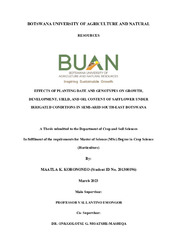| dc.description.abstract | Safflower (Carthamus tinctorius L.) is an annual oil plant belonging to the Compositae or Asteracea family that can be grown as a summer or winter crop. One of the most important criteria for maximising safflower production is choosing the right planting date. Therefore, the objective of this study was to evaluate how safflower growth, development, yield, and oil content were affected by planting date and genotype. The Botswana University of Agriculture and Natural Resources content farm served as the site of field studies. Three replications of a 4 x 4 factorial in randomised blocks made up the experimental design. The treatments were planting dates (15th of December, January, March, and May) and safflower four genotypes (Sina, PI537636, Gila, and PI527710). The results showed that planting date and genotype significantly (P < 0.05) interacted to influence phenological variables (days to 50% flowering and physiological maturity), vegetative growth (LAI, LAD, NAR, CGR, and leaf chlorophyll content), yield components (seed number/capitulum, 1000-seed weight, biological yield, and harvest index), and oil content with the genotype Sina when planted in May producing the highest variables. Planting date and genotypes independently significantly (P < 0.05) influenced also vegetative growth (plant height, primary branch number, and plant stem diameter), yield components (capitula diameter and capitula number/plant), seed yield, and oil yield with genotype Sina planted in May producing the highest variables. The other genotypes PI57636, PI527710 and Gila were also recommended for commercial growing due to their high seed yield and oil content above 28% (threshold hold for commercial oil production) under favourable growing conditions, and multiple uses of safflower. For early planting in summer, January planting was recommended because it was the second-best planting date. Planting in March was highly discouraged as plant performance was drastically reduced due to unfavourable chilling temperatures converging at a sensitive phenological stage (onset of flowering) | en_US |

